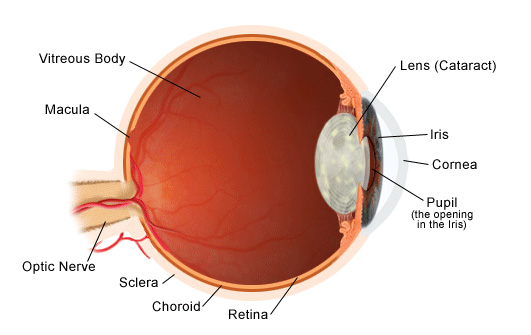
Save Your Eyes From Cataracts: N-Acetylcarnosine (NAC)
May 8, 2017 Puzzle Piece
At
a Bemer Seminar I met a Medical Doctor that did a presentation on how
he used Bemer and Nutrition for the eyes. He showed pictures of before
and after where his patients had recovered from macular degeneration and
cataracts to differing degrees. He is the formulator of the Magna Eye
Drops that have been tried and tested.
Cataracts
are the leading cause of blindness, accounting for about 42 percent of
all cases of blindness worldwide (affecting about 17 million people).
Twenty-eight thousand new cases are reported everyday. About 20 percent
of all people over 60 have at least the beginning of a cataract in one
or both eyes, and that figure rises to 80 percent for people over 75.

Causes of Cataracts
Causes
of cataracts include cumulative ultraviolet radiation damage from sun
exposure, heredity, poor nutrition, smoking, high blood pressure, kidney
disease, diabetes, and the long-term use of corticosteroids (the last
two are major risk factors for cataracts). Oxidative free radicals
produced by the above-listed causes are thought to damage vital
biomolecules, including lipids and proteins, resulting in the clumping
together of these proteins. The antidote to free radicals, of course, is
antioxidants, such as glutathione, lipoic acid, and vitamins C and E.
Consequently, many scientists believe that abundant consumption of
antioxidants may delay the onset of cataracts.
Nutrients for Vision
Good
nutrition is a key element of effective prevention for most age-related
diseases, and cataracts are no exception. A number of nutrients can
benefit our eyes, and may help prevent diseases such as cataracts,
glaucoma, and macular degeneration. These nutrients include the
tripeptide glutathione (the most abundant and important antioxidant in
the human body, critical for protecting the lens from free radical
damage); vitamins A and C; vitamin E and some of the B vitamins; various
bioflavonoids (especially quercetin and hesperidin) and carotenoids
(especially lutein and zeaxanthin); the amino acids taurine,
N-acetylcysteine (a precursor of glutathione), and acetyl L-carnitine;
the hormone melatonin; the alkaloid vinpocetine; the herbs bilberry,
ginkgo, and garlic; the minerals zinc and selenium; and, last but
certainly not least, the saturated fatty acid, lipoic acid (“the
antioxidant’s antioxidant”), which plays a central role in maintaining
the body’s antioxidant network.
Cataract-Dissolving Analog: N-Acetylcarnosine (NAC)
N-acetylcarnosine
(NAC), like its parent compound, carnosine, occurs naturally throughout
the human body. Both compounds are found primarily in the heart and
skeletal muscles (the word carnosine is derived from the Latin word for
flesh) and in the brain. Carnosine was discovered in 1900 in Russia, and
it is in Russia that most of the recent research on the
N-acetylcarnosine derivative has been carried out. Research with
N-acetylcarnosine, as with carnosine, demonstrates that it is effective
not only in preventing cataracts but also in treating them. NAC has been
shown to improve vision by partially reversing the development of the
cataract, thus increasing the transmissivity of the lens to light.
The structural difference between NAC and carnosine is that one
hydrogen atom in carnosine replaces an acetyl group (CH3CO-), and this
substitution occurs at a nitrogen atom. An important chemical difference
between carnosine and N-acetylcarnosine is that carnosine is relatively
insoluble in lipids (fats and fatty compounds), whereas
N-acetylcarnosine is relatively soluble in lipids (as well as in water).
This means that N-acetylcarnosine may pass through the lipid
membranes of the corneal and lens cells more easily than carnosine, and
may thereby gain access more readily to the cells’ interior, which is
primarily aqueous. There, the N-acetylcarnosine is gradually broken down
to carnosine (and, perhaps, to histidine), which then exerts its
beneficial effects.
N-Acetylcarnosine also Reduces Cataracts
In
one study, Russian scientists conducted two randomized, double-blind,
placebo-controlled trials of 6-months and 24-months duration, with eye
drops consisting of a one percent aqueous solution of NAC administered
as two drops twice daily. They treated a total of 49 elderly patients
(average age 65) with cataracts ranging in severity from minimal to
advanced, (but not to the point of requiring surgery); the total number
of eyes affected was 76. Using a variety of sophisticated optical
techniques, they monitored the condition of the cataracts, visual
acuity, and glare sensitivity.
The eyes treated with NAC were substantially improved in 6 months:
the measured transmissivity of the lenses increased in 42 percent of
the eyes, by 12-50 percent; in 90 percent of the eyes, visual acuity
improved by 7-100 percent; and in 89 percent of the eyes, glare
sensitivity improved by 27-100 percent. These improvements were
sustained for the duration of the 24-month trial. In no eyes was any
worsening of the condition seen. By contrast, the condition of the
untreated eyes in the control group worsened. Visual acuity dropped in
89 percent of the controls by 17-80 percent after 24 months.
Another interesting study by the same team also evaluated patients
between the ages of 48 and 60, who had various degrees of eyesight
impairment, but who did not have the symptoms of cataract. After a
course of treatment ranging from 2 to 6 months, the conclusion was that
the eye drops alleviated eye-tiredness and continued to improve eyesight
(i.e. there was more clear vision). The subjects reported that the
treatment “brightened” and “relaxed” their eyes. This is an important
indicator that the eye drops have a value both for preventive purposes,
as well as medical applications.
Magna
Nutrients Eye Drops have N-Acetylcarnosine, plus other very important
nutrients for eye health. Give them a try for yourself and your
patients. I use it at one drop in the morning and one at bedtime in
each eye.
Yours in Health and Wellness,
John W Brimhall, BA, BS, DC, FIAMA, DIBAK
(Only registered customers can rate)
There are no comments for this product.